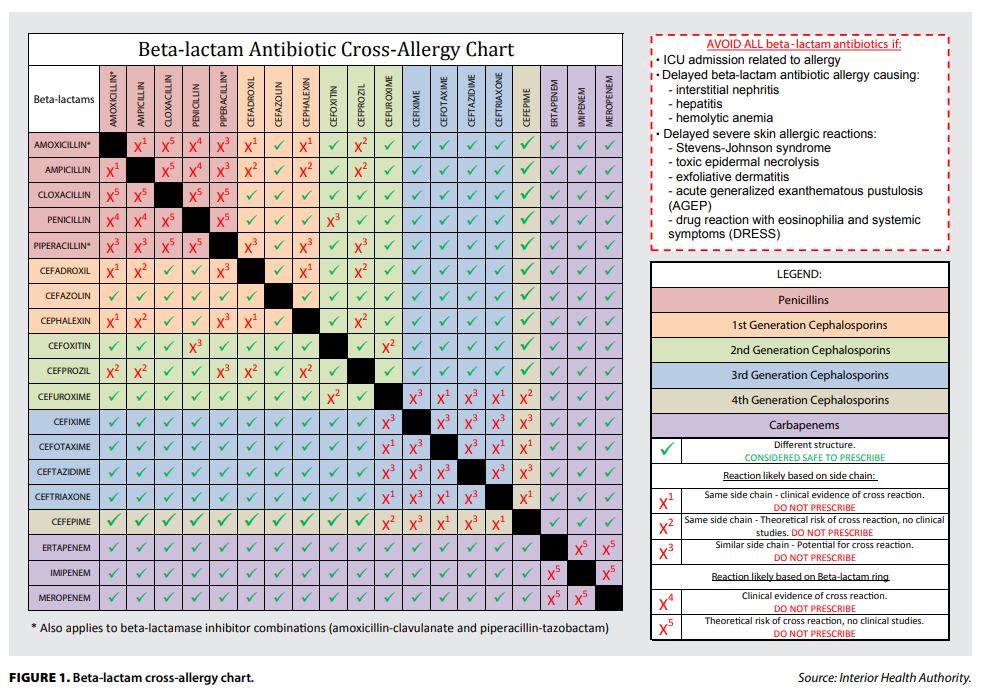Cefuroxime is a Safe Alternative for Penicillin Allergic Patients
In light of the increasing concern over antibiotic misuse, particularly the overprescription of clindamycin in dentistry, the BC Centre for Disease Control (BCCDC) and the UBC Therapeutics Initiative (TI) have collaborated to provide dentists with prescribing Portraits aimed at improving antibiotic use. Pharmacists and pharmacy technicians play an important role in determining the safety of alternative antibiotics and communicating with patients. Luckily, safe alternatives to clindamycin exist for patients with true penicillin allergies, including the beta-lactam antibiotic cefuroxime.
Surveillance on dental antibiotic prescribing in BC have shown alarmingly high rates of clindamycin prescribing in comparison to international studies.1 One reason for high rates of clindamycin prescribing is its use as an alternative agent for “penicillin allergic” (PCN-allergic) patients. The best available evidence indicates that clindamycin is not more effective yet is more strongly associated with the development of C. difficile colitis than other antibiotics.2
Beta-lactam allergies, particularly allergies to penicillin, are overreported, with about 10% of individuals reporting an allergy in the US.3 However, most reported penicillin allergy is not associated with clinically significant IgE-mediated reactions after penicillin rechallenge.4
Recent studies have also shown that the cross-reactivity between penicillins and cephalosporins is less than 1% (and no way near the originally quoted 5% rate).5 Cross-reactivity rate between penicillin and cephalosporins depends on the similarity of side chain structure.6 For example, cephalexin has a similar side chain and is not safe for PCN-allergic patients. But, because cefuroxime’s side chain does not resemble that of amoxicillin or penicillin, it can be used safely.7 Very rare but severe reactions such as Stevens-Johnson syndrome, which includes the peeling of skin and usually requires intensive care, remain contraindications to prescribing any beta-lactam (including all cephalosporins).
The following advice is being given by BCCDC and the TI to dentists:
- Do not use clindamycin routinely for prophylaxis or management of dental infections. Cefuroxime is a safe option for most patients who have a true penicillin allergy.
Details for antibiotic selection for prophylaxis and treatment of dental infections
In the few patients for whom Bugs & Drugs suggests prophylaxis, the following treatment is recommended:
- A single 2g oral dose of amoxicillin given 30-60 minutes before dental surgery, OR
- A single 500mg oral dose of cefuroxime, if the patient has penicillin allergy
When you receive a cefuroxime prescription from a dentist for a patient with penicillin allergy, remember that it is a safe option, and may be dispensed.
For further information, please refer to:
- Bugs & Drugs: Antimicrobial treatment guidelines, including recommendations for antibiotic use for dental infections.
- Beta-Lactam Allergy Delabelling Guideline and Toolkit: Developed by the Provincial Antimicrobial Clinical Expert (PACE) group, to support practitioners in assessing and managing patients who report an allergy to penicillin or other beta-lactam antibiotics.
- Antimicrobial Stewardship on the BCCDC website: a selection of clinical tools and resources to aid practitioners in stewardship efforts in their practice.
References
- Thompson W, Teoh L, Hubbard CC, et al. Patterns of dental antibiotic prescribing in 2017: Australia, England, United States, and British Columbia (Canada). Infect Control Hosp Epidemiol 2021; 1–8;
- Brown KA, et al. Antimicrobial Agents & Chemotherapy 2013; 57(5):2326–32;
- Macy E. Curr. Allergy Asthma Rep 2014;14:476;
- Sacco KA, et al. Allergy 2017;72:1288-1296;
- Zagursky RJ, Pichichero ME. J Allergy Clin Immunol Pract. 2018;6(1):72-81;
- Picard M, et al. The Journal of Allergy & Clinical Immunology in Practice 2019; 7(8):2722-2738.e5. DOI: 10.1016/j.jaip.2019.05.038;
- Patrick DM, et al. BCMJ 2019; 61(9):350–351,361. https://bcmj.org/bccdc/beta-lactam-allergy-benefits-de-labeling-can-be-achieved-safely.
About the Authors
Nick Smith, MPH
Project Manager, Community Antimicrobial Stewardship
BC Centre for Disease Control
Fawziah Lalji, BSc(Pharm), PharmD, FCSHP
Professor, Faculty of Pharmaceutical Sciences
University of British Columbia
 Share
Share



